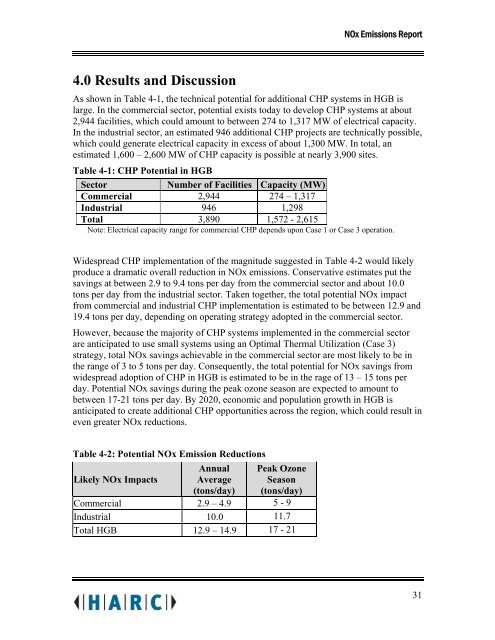NOx Emissions Impacts from Widespread Deployment of CHP in ...
NOx Emissions Impacts from Widespread Deployment of CHP in ...
NOx Emissions Impacts from Widespread Deployment of CHP in ...
Create successful ePaper yourself
Turn your PDF publications into a flip-book with our unique Google optimized e-Paper software.
4.0 Results and Discussion<br />
<strong>NOx</strong> <strong>Emissions</strong> Report<br />
As shown <strong>in</strong> Table 4-1, the technical potential for additional <strong>CHP</strong> systems <strong>in</strong> HGB is<br />
large. In the commercial sector, potential exists today to develop <strong>CHP</strong> systems at about<br />
2,944 facilities, which could amount to between 274 to 1,317 MW <strong>of</strong> electrical capacity.<br />
In the <strong>in</strong>dustrial sector, an estimated 946 additional <strong>CHP</strong> projects are technically possible,<br />
which could generate electrical capacity <strong>in</strong> excess <strong>of</strong> about 1,300 MW. In total, an<br />
estimated 1,600 – 2,600 MW <strong>of</strong> <strong>CHP</strong> capacity is possible at nearly 3,900 sites.<br />
Table 4-1: <strong>CHP</strong> Potential <strong>in</strong> HGB<br />
Sector Number <strong>of</strong> Facilities Capacity (MW)<br />
Commercial 2,944 274 – 1,317<br />
Industrial 946 1,298<br />
Total 3,890 1,572 - 2,615<br />
Note: Electrical capacity range for commercial <strong>CHP</strong> depends upon Case 1 or Case 3 operation.<br />
<strong>Widespread</strong> <strong>CHP</strong> implementation <strong>of</strong> the magnitude suggested <strong>in</strong> Table 4-2 would likely<br />
produce a dramatic overall reduction <strong>in</strong> <strong>NOx</strong> emissions. Conservative estimates put the<br />
sav<strong>in</strong>gs at between 2.9 to 9.4 tons per day <strong>from</strong> the commercial sector and about 10.0<br />
tons per day <strong>from</strong> the <strong>in</strong>dustrial sector. Taken together, the total potential <strong>NOx</strong> impact<br />
<strong>from</strong> commercial and <strong>in</strong>dustrial <strong>CHP</strong> implementation is estimated to be between 12.9 and<br />
19.4 tons per day, depend<strong>in</strong>g on operat<strong>in</strong>g strategy adopted <strong>in</strong> the commercial sector.<br />
However, because the majority <strong>of</strong> <strong>CHP</strong> systems implemented <strong>in</strong> the commercial sector<br />
are anticipated to use small systems us<strong>in</strong>g an Optimal Thermal Utilization (Case 3)<br />
strategy, total <strong>NOx</strong> sav<strong>in</strong>gs achievable <strong>in</strong> the commercial sector are most likely to be <strong>in</strong><br />
the range <strong>of</strong> 3 to 5 tons per day. Consequently, the total potential for <strong>NOx</strong> sav<strong>in</strong>gs <strong>from</strong><br />
widespread adoption <strong>of</strong> <strong>CHP</strong> <strong>in</strong> HGB is estimated to be <strong>in</strong> the rage <strong>of</strong> 13 – 15 tons per<br />
day. Potential <strong>NOx</strong> sav<strong>in</strong>gs dur<strong>in</strong>g the peak ozone season are expected to amount to<br />
between 17-21 tons per day. By 2020, economic and population growth <strong>in</strong> HGB is<br />
anticipated to create additional <strong>CHP</strong> opportunities across the region, which could result <strong>in</strong><br />
even greater <strong>NOx</strong> reductions.<br />
Table 4-2: Potential <strong>NOx</strong> Emission Reductions<br />
Likely <strong>NOx</strong> <strong>Impacts</strong><br />
Annual<br />
Average<br />
(tons/day)<br />
Peak Ozone<br />
Season<br />
(tons/day)<br />
Commercial 2.9 – 4.9 5 - 9<br />
Industrial 10.0 11.7<br />
Total HGB 12.9 – 14.9 17 - 21<br />
31
















